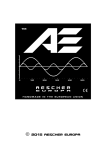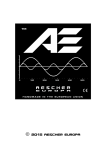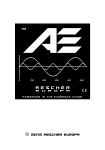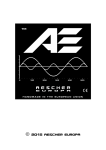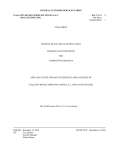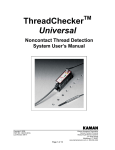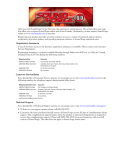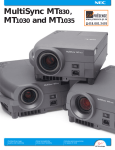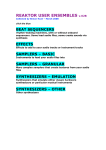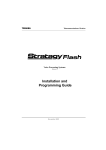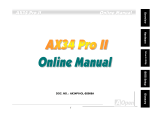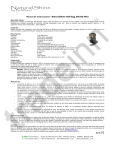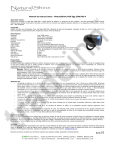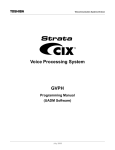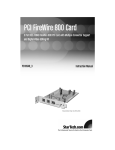Download user manual
Transcript
2015 AEScHER EUROPA E10 - User Manual E Series 1 1.1 1.2 1.3 SET UP Overview Battery Compartment Functions 2 2.1 2.2 2.3 2.4 2.5 2.6 2.7 OPERATION Instrument Compatibility Handling String Mounting & Tracking String Driving Proximity Effects Onboard Effects Maintenance 1 SET UP 1.1 Overview The SRG E Series are a line of handheld, internally powered string resonators, based on nano scale SMDI architecture Available in monophonic and polyphonic models. The ● ● SRG E10 package includes : E10 Handheld Integrated Polyphonic Guitar Resonator 9V Alkaline-Manganese Primary Cell Battery Optional Accessories : ● ● ● XL6 Divided String Sensor Kit Hc -1 Holster Clip RX-9 Rechargeable 9 volt Battery The E10 is the world's first Handheld Polyphonic Resonator. Featuring 3 modes of operation, and effect triggers for LPF, HPF and MUTE for both Left and Right Channel. The E10 can operate in Polyphonic Mode or Monophonic Mode, simply by switching OFF the Left Channel or Right Channel Power Switch. The E10 is designed specifically for guitar, featuring highly inductive, low resonant frequency sensor and driver coils - directly wound on neodymium core magnets. The E10 also features protruding FANG rails for accurate string tracking and 2 ultra bright - deep blue LED power indicators – one for each string. SET UP > After unpacking the box, check that the power switches are in the OFF position (downwards), remove the battery cover and slide the included 9 Volt Battery into the battery compartment until firmly connected, then replace the cover. The battery cover is precision crafted to a tight slip-fit tollerance and held in place by mechanical tension; It is therefore important to fully close the battery cover, and take care not to misplace or step on the cover when removed. Be sure to check that the power switches are OFF before connecting the battery, and that the + polarity is correctly orientated – as illustrated on page 6. Switch the 2 power switches Left and Right (fully upwards) to the ON position. The blue LED power indicators will light up instantly when the power switches are on. If the LEDs do not light, or flicker – either the battery is not firmly connected, or the battery may be weak or dead. The E10 is fully operational the moment the 2 blue LEDs are on. 1.2 Battery Compartment The E Series features an ultra-fast slide-in battery compartment for an internal 9 volt primary cell. Eliminating the frustration of fumbling in the dark with clumsy floppy wire 9 volt battery connectors, the E Series slide mount battery port allows rapid battery changes in as little as 5 seconds. The E 3o includes a 9 volt Alkaline-Manganese primary cell, which is safely disposable. Under No Circumstances is the battery to be recharged or dismantled. The storage life of the battery is 5 years. Do not install a typical rechargeable NiMH battery, as typical rechargeable 9V batteries actually supply only 8.4 volt rather than 9 volt. The E 3o requires a full 9 volt at 55 mA for stable operation. If a rechargeable battery solution is needed, then use the optional RX-9 Rechargeable 9 volt Battery, which supplies a full 9.6 volts and 200 mA/h of charge. WARNING - Damage resulting from the use of incorrect rechargeable batteries, oversized batteries or incorrect installation can invalidate the warranty ! 1.3 Functions The E10 includes 3 onboard trigger effects per channel : • • • LPF (low pass filter) HPF (high pass filter) MUTE The forward left side trigger activates Left Channel LPF Mode, attenuating high frequencies by 26 dB, with the effect of a bass boost, which produces a cello effect on heavy gauge strings. The backward left side trigger activates HPF Mode, attenuating low frequencies and enhancing harmonics. The forward left side round button activates the Left Channel MUTE function. The forward right side trigger activates Right Channel LPF Mode, The backward right side trigger activates HPF Mode. The forward right side round button activates the Right Channel MUTE function. Rapid triggering or alternated triggering produces some very interesting special effects available only to the SRG. 2 OPERATION 2.1 Instrument Compatibility The SRG functions on any stringed instrument with ferromagnetic strings, including plain steel strings and steel core strings. The E10 is equally effective on light and heavy gauge strings, and optimised for a 12 mm bridge saddle spacing, as the pole spacing on the E10 is 11 mm, accounting for a standard 648 mm string length, and 42 mm nut. However the E10 also works perfectly well on narrow Steinberger guitar spacing. The inner tracking rails on the E10 span 4 strings, 2 support strings and 2 resonated strings. The unique "Fang" rail design allows more stable and accurate string mounting and tracking. The E10 should Only be held over an XL6 Divided String Sensor in Polyphonic Mode! Where each driver feeds a single coil, for normal hard driving string resonance. The E10 should NOT be held directly over a Normal Guitar Pickup in Polyphonic Mode, as the combined feedback of 2 drivers can cause harmonic saturation and signal overload! The SRG is also capable of driving Acoustic Steel String Instruments without electromagnetic transducers , although the tonal effects are less audible. 2.2 Handling The SRG E Series is designed to be handheld between the thumb and index finger with the middle and ring fingers free to operate the triggers, with the LEDs facing towards the nut of the instrument. 2.3 String Mounting & Tracking Place the guide rails on the 2 outer support strings, with the support strings on the inside of the "Fangs". The SRG should rest absolutely level on the guide strings, and never tilted to one side. It's important to get a feel for the optimal positioning of the SRG, through persistent practice. Proper use of a cello bow is not learned in a day, and neither is the proper use of an SRG – both take practice! 2.4 String Driving String driving (resonance) will initiate immediately after holding the SRG steady and level on the support strings. Any deviation from top dead centre above and parallel to the driven string will result in various effects, the most obvious being fade in / fade out, and reverse envelope effect. All positional effects are a result of deviation from parallel top dead centre above the driven string. The best path to finding desirable effects is through constant experimentation. 2.5 Input Transducer Effects In Monophonic mode, various Legato and Staccato effects are possible through the proximity and forward / backward angular relationship between the driver and the magnetic core of the input transducer (pickup) on the instrument. Most useful effects depend on this distance and angular relationship Provoking the input transducer in every conceivable manner will result in the discovery of more than a few useful effects. Note* The use of a headphone amp during the lower end of the learning curve is highly recommended. Extraordinary efforts have been made in molesting the guitar to badly imitate the sounds of other instruments. The best advice this manual can offer, is to use "other instruments" rather than trying to imitate them, and discover "New" sounds with the SRG. 2.6 Onboard Effects The E10 has 3 Operating Modes : • Normal Mode • LPF Mode • HPF Mode And also MUTE function 2.7 Maintenance If possible - always store the SRG in a dry, dust-free environment at room temperature (15 - 20° C). Always remember to switch the E10 OFF when not in use. Clean the SRG using a soft cotton cloth or t-shirt soaked in warm water, tight places may be cleaned using a cotton bud. To remove minor scratches – the SRG may be polished using 1000 grit wet & dry sandpaper and rubbed with vegetable oil. Never attempt to clean any part of the SRG with alcohol, acetone, ammonia, or any household cleaner! TECHNICAL SPECIFICATIONS SRG MODEL E10 Pole Spacing Supply Voltage Power Output Driver Resonant Frequency Sensor Resonant Frequency Core Magnets Quiescent Current Drain Operating Current Drain Voltage Gain LPF Attenuation THD Storage Temperature Operating Temperature Width Length Height Mass (without battery) 11 mm 9V 500 mW 2300 Hz 2300 Hz Neodymium 8 mA 55 mA 46 dB 26 dB 0.2% 15° - 25° C 0° - 35° C 44 mm 60 mm 60 mm 75 g

















